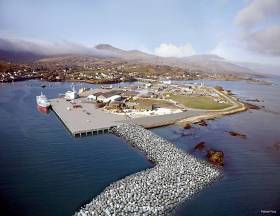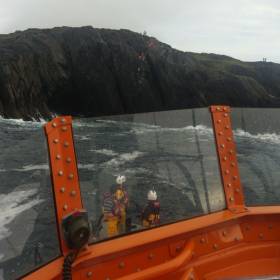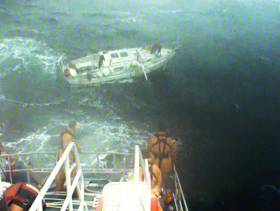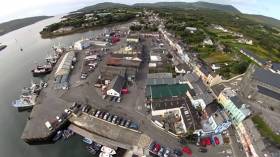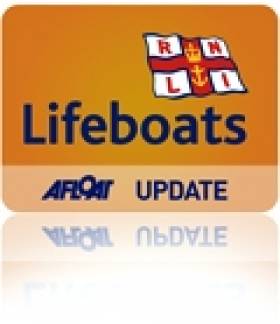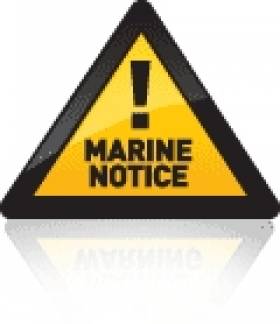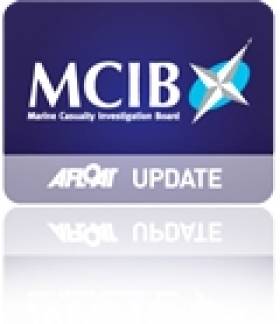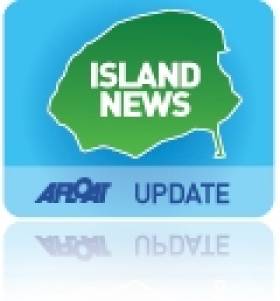Displaying items by tag: castletownbere
Creed Announces Major €21m Integrated Harbour Development Project in Castletownbere
Castletownbere Lifeboat Joins Multi-Agency Rescue In Dursey Sound
#RNLI - Castletownbere RNLI’s lifeboat was tasked just before noon yesterday (Sunday 13 November) to go to the aid of a man trapped a ledge on the shore in the Dursey Sound.
The lifeboat, under the command of second coxswain Paul Stevens, was launched within seven minutes and arrived on scene 35 minutes later, where the casualty was located at the bottom of a cliff on a narrow ledge and suspected to be suffering from hypothermia.
Given the dangerous 3-4m swell on the shoreline, the lifeboat was unable to launch its inflatable Y-boat.
The Shannon-based Irish Coast Guard helicopter Rescue 115 was also on scene but unable to deploy a winchman given the adverse conditions.
However, the lifeboat was able to provide the coastguard with details of the casualty's location through radio contact.
The local Castletownbere Coast Guard shore-based rescue unit lowered one of its team down the rock face who was able to secure the casualty before both were carefully brought up the cliff.
On receiving a medical assessment from ambulance crew, the casualty was transferred to Tralee General Hospital by helicopter.
#RNLI - The Castletownbere lifeboat Annette Hutton was launched early yesterday morning (Saturday 20 August) when Valentia Coast Guard Radio requested assistance to a yacht in difficulties 45 miles south of Mizen Head in West Cork.
The 8m yacht with one person on board had left the Azores in early August and ran into difficulties in yesterday's severe weather.
The sailor, in his 60s, had been in regular radio contact with Valentia Coast Guard radio until yesterday morning, when his VHF radio was washed overboard. He activated an EPIRB to identify his location, raise the alarm and seek help.
The lifeboat, under the command of coxswain Brian O’Driscoll, was launched at 8am and located the casualty at 10.40am, some 50 miles south-west of Castletownbere. An Irish Coast Guard rescue helicopter was also on scene. Conditions were described as gusting Force 8/9 winds with a 30ft swell.
Amid the challenging sea conditions, the yacht was taken under tow and the lifeboat proceeded slowly to Castletownbere. Early into the tow, the lifeboat crew became concerned about the wellbeing of the sailor and the crew managed to transfer him to the lifeboat.
With the damaged yacht in tow, the lifeboat returned to Castletownbere at 8.30pm, having been at sea for 12-and-a-half hours.
Last night the sailor thanked the Castletownbere lifeboat and all involved for "saving his life", saying: "Only for the lifeboat, things would have ended up very badly today."
Commenting on the callout, Castletownbere RNLI lifeboat operations manager Tony O’Sullivan added: "The coxswain and crew are to be complimented on today’s rescue – they demonstrated skill, seamanship and endurance during what was a long and challenging day."
Castletownbere RNLI rescued two fishermen from a sinking vessel in the early hours of this morning. The volunteer crew was requested to launch their all-weather lifeboat at 4.45am to go to the assistance of a fishing vessel which was reported sinking 11 miles south west of Dursey Island on the Beara peninsula.
The Castletownbere lifeboat under Coxswain Brian O’Driscoll and with six crew members onboard was launched minutes later at 4.55am.
Weather conditions at the time were described as good with a Force three to four wind and good visibility.
The naval vessel LE Orla and the Irish Coast Guard’s Rescue 115 helicopter were also tasked.
The lifeboat was on scene at 5.50am where the crew found two fishermen in a life raft.
Both men were taken aboard the lifeboat and were reported to be safe and well.
The lifeboat arrived back to Castletownbere at approximately 8am this morning.
Speaking following the call out, Paul Stevens, Castletownbere RNLI Volunteer Lifeboat Press Officer said: ‘Fortunately the weather conditions were favourable early this morning and we were able to quickly transfer the two fishermen into the safety of the lifeboat. Both are safe and well. They did the right thing this morning and raised the alarm when they got into difficulty.
‘This morning’s call out came as the RNLI prepared to launch its Respect the Water campaign today,
#MarineNotice - The latest Marine Notice from the Department of Transport, Tourism and Sport (DTTAS) advises that site investigation works are to be carried out at Castletownbere Fishery Harbour Centre in West Cork.
The work will comprise of drilling multiple boreholes at the locations, subject to minor variations, indicated in Marine Notice No 24 of 2016, a PDF of which is available to read or download HERE.
Work was expected to begin yesterday (Thursday 26 May) and will finish on or around Friday 22 July, weather permitting.
A jack-up barge will be moved to the various borehole locations by a tugboat and will remain on site overnight during the operations.
All appropriate lights will be displayed by the barge at night. Radio warnings will be transmitted on VHF channel 16 throughout the works.
Castletownbere RNLI Recovers British Adventurer’s Transatlantic Vessel Abandoned in Hurricane
Castletownbere RNLI has recovered a British adventurer’s transatlantic boat which was abandoned in a hurricane some 400 miles west of Portugal.
In what was their first call out of 2016, the volunteer lifeboat crew was requested to go the assistance of a boat yesterday afternoon (Tuesday 5 January) which was reported to be floating about 500m from the shore in Dunmanus Bay.
The lifeboat launched in Force Seven winds at 2.50pm and made its way amid a large sea swell to the scene, arriving at 3.27pm.
On arrival the crew noted that the boat Happy Socks was unmanned. The lifeboat crew proceeded to take the vessel under tow and bring her safely to Castletownbere.
Speaking following the call out, Paul Stevens, Castletownbere RNLI Lifeboat Press Officer said: ‘It transpired that this boat had been abandoned two months ago 400 miles west of Portugal by a lone oarswoman who was rowing from Cape Cod to London. She abandoned the boat in a hurricane and was picked up by a Canadian vessel.’
The British adventurer Sarah Outen MBE successfully completed her London2London expedition in November having set out from Tower Bridge in April 2011. Her goal via the world expedition was to row, bike and kayak the northern hemisphere, inspiring children and fundraising for charities. In her four and a half year adventure which saw her cover 25,000 miles, Sara overcame huge obstacles and endured extreme conditions in remote environments, including the hurricane on the Atlantic last year which forced a pre-emptive evacuation after 143 days at sea.
On hearing the good news about Happy Socks, Sarah phoned Castletownbere lifeboat station and tweeted last night: ‘Today I got that wonderful sort of news that makes your tummy turn and tears flow and rocks your happy socks off. Happy Socks is safe. We are making plans to go and retrieve her from SW Ireland where the @RNLI crew in Castletownbere found her today, just 500m from shore. A big and very grateful shoutout to the @RNLI crew at Castletownbere for bringing her in and letting us know. Go Happy Socks!’
Castletownbere Lifeboat Crew Honoured At National Water Safety Awards
#RNLI - Two members of Castletownbere’s RNLI lifeboat crew were honoured at Irish Water Safety’s national award ceremony in Dublin Castle this week.
Lifeboat mechanic Martin O’Donoghue and crewmember and Garda Dave Fenton, together with his colleague Garda Caroline Guest, were among 35 people honoured at the ceremony on 18 November.
Irish Water Safety says the actions of these 35 people saved the lives of 22 people who got into difficulty. Last year there were 91 drownings in Ireland, the lowest since 1936.
On 4 May last at The Pier in Castletownbere, Gardaí Fenton and Guest were on patrol when they received a call that a man had fallen into the water.
They rushed to the scene where Garda Guest threw a lifebuoy to the man while Garda Fenton secured a rope ladder to the pier and climbed down into the water to the casualty. He managed to get the man to hold onto the ladder while using the ringbuoy as a buoyancy aid. Garda Guest telephoned O’Donoghue to assist them.
While Garda Guest reassured and waited with the casualty, Garda Fenton and O’Donoghue launched a boat and were able to get alongside the casualty and pull him out of the water.
They then brought him to safety and waited with him until emergency services arrived. The man subsequently made a full recovery.
Tony O’Sullivan, lifeboat operations manager at Castletownbere Lifeboat Station congratulated the award recipients, saying: "The comprehensive and rigorous training undertaken by crewmembers in the RNLI was most certainly a factor in this successful rescue."
Wave Measuring Device at Castletownbere Fishery Harbour Centre, Co. Cork
#castletownbere – The Department of Transport, Tourism and Sport has been advised that a wave measuring device has been installed on the seabed, adjacent to the Walter Scott Rock, at co-ordinates Latitude 51° 38' 33.6"N, Longitude 009° 54' 20.4"W. A yellow floating marker buoy with a special mark beacon has been installed to indicate the location of the device.
The wave study is being carried out by the Marine Engineering Division of the Department of Agriculture, Food & the Marine. The study is expected to be on-going until late March 2015, weather permitting.
For safety reasons, mariners are requested to keep a sharp lookout and to proceed slowly and with extreme caution in the vicinity of the Walter Scott Rock.
For safety reasons, fishermen are requested to avoid dredging at the co-ordinates mentioned above. Fisherman should take great care when dredging near this location and keep a wide berth from the device which is located on the seabed.
MCIB Issues Report On Castletownbere Drowning
#MCIB - A poorly positioned lobster pot hauler and failure to maintain a working PFD have been identified among the main contributing factors in the death of a retired schoolteacher and recreational fisherman off West Cork two years ago.
That's according to the Marine Casualty Investigation Board's (MCIB) report on the incident off the Beara Peninsula on 17 August 2012, in which 66-year-old Pearse Lyne drowned after his fishing boat capsized.
As previously reported on Afloat.ie, Lyne's death was the second tragedy to befall the Castletownbere area in mid August 2012, occurring just days after farmer and poet John O'Leary drowned off Cod's Head.
The MCIB report established that Lyne had set out to sea on the morning of 17 August 2012 in a hurry to retrieve his lobster pots as that year's fishing season closed out.
Though Met Éireann's reports on the day's weather conditions were favourable, anecdotal evidence from local mariners at the time suggest a heavy swell in the area.
Investigators also found that Lyne's unregistered boat, while in sound working order, had its lobster pot hauler fitted on the starboard stern quarter, not in the usual forward position, which may have made affected the boat's stability – although it is unclear exactly what caused the capsize.
In addition, Lyne was found not to be wearing a lifejacket or PFD when his body was removed from the water, though there is evidence he was attempting to access one from the forward locker when he was overcome by the situation.
But even if he had, the PFD found on board his vessel was determined to be defective, with its gas cartridge already expended.
The report recommends that a Marine Notice be issued recommending all mariners inspect their PFDs for defects such as expired or expended gas inflation cylinders.
The complete MCIB report can be downloaded as a PDF below.
Remembering The First Cable Car In Ireland At Garnish
#cablecar – Lehanmore Community Co-Op at Garnish on the Beara Peninsula are planning a re-enactment of what they describe as "the first-ever cable car journey to an island in Ireland." writes Tom MacSweeney.
It will be held at Crow Head on Saturday, September 6 and will involve Kerry Mountain Rescue Team, Castletownbere Coast Guard and Castletownbere RNLI according to Paul O'Shea, the Co-op Chairman,
"The first cable car crossing was by a cable rigged up by a prominent farmer Tadgh Roger O'Sullivan from Scrivogue, Garnish, between the mainland and one of the islands to transport his sheep," Lynette Dewhurst, one of those organising the event, said.
"Tadhg's idea gave the impetus and led to the Dursey cable car, unique in Ireland and which is very well-known today. The re-enactment which we are planning will also be a joint training session between the rescue services. The actual setting-up of the re-enactment will be extremely interesting as ropes will be fired hundreds of feet above the Atlantic to then be moored between the mainland and an island. Members of the rescue service will then travel via the cable."
Shuttle buses will transport spectators from Lehanmore Centre to the demonstration site. As the viewing area is in close proximity to the sea, stewards will guide everybody.
"We are asking spectators to be prepared for all weathers as it is an exposed area and donation buckets will raise funds for Kerry Mountain Rescue. A series of talks will be held at Lehanmore Community Centre hosted by the rescue services, where there will be food and refreshments available throughout the day and the evening, with live music from 7pm till late."


























